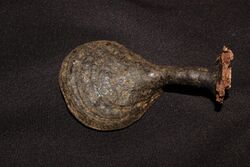Biology:Ganoderma orbiforme
| Ganoderma orbiforme | |
|---|---|

| |
| Scientific classification | |
| Domain: | Eukaryota |
| Kingdom: | Fungi |
| Division: | Basidiomycota |
| Class: | Agaricomycetes |
| Order: | Polyporales |
| Family: | Ganodermataceae |
| Genus: | Ganoderma |
| Species: | G. orbiforme
|
| Binomial name | |
| Ganoderma orbiforme (Fr.) Ryvarden (2000)
| |
| Synonyms | |
| |
Ganoderma orbiforme – most commonly known as G. boninse or just Ganoderma in oil palm pathology – is a species of polypore fungus that is widespread across southeast Asia. It is a plant pathogen that causes basal stem rot, a disease of the African oil palm (Elaeis guineensis). The fungus was first described scientifically in 1838 by Elias Magnus Fries from collections made in Guinea.[1] Leif Ryvarden transferred it to the genus Ganoderma in 2000. In addition to its type locality, the fungus has also been collected from the Bonin Islands in the Pacific, and from Venezuela and Puerto Rico.[2]
Transmission
G. orbiforme is not a soil borne pathogen as it does not grow in soil and does not infiltrate from soil and into the root system. It is however also not killed by soil, and will reside in dead, buried palm trunk material. This has especially been observed when Oryctes rhinoceros-infested material was buried.[3]:417
Infection
Ganoderma orbiforme has a hemibiotrophic lifestyle in E. guineensis.[4] During an invasion, E. guineensis roots stockpile salicylic acid, which is a signal to downregulate its own expression of ascorbate oxidase and ascorbate peroxidase. AO and AP are reactive oxygen species scavengers, and so the total effect is to increase ROS production. This entire pathway was found by Ho et al. 2016. Increased ROS is effective against hemibiotrophs but counterproductive against necrotrophs.[5]
Genetics
Microsatellite markers have been developed to help identify the fungus and study the genetic diversity of G. orbiforme.[6]
References
- ↑ Fries, E.M. (1838) (in la). Epicrisis Systematis Mycologici. Uppsala: Typ. Acad.. p. 463. https://archive.org/details/bub_gb_bYdIAAAAYAAJ.
- ↑ Ryvarden, Leif (2000). "Studies in neotropical polypores 2: a preliminary key to neotropical species of Ganoderma with a laccate pileus". Mycologia 92 (1): 180–191. doi:10.2307/3761462.
- ↑ Corley, R. H. V.; Tinker, P. B. (2015-10-03). The Oil Palm. Chichester, UK: John Wiley & Sons, Ltd. doi:10.1002/9781118953297. ISBN 978-1-118-95329-7. S2CID:82631705
- ↑ Bahari, Mohammad Nazri Abdul; Sakeh, Nurshafika Mohd; Abdullah, Siti Nor Akmar; Ramli, Redzyque Ramza; Kadkhodaei, Saied (2018). "Transciptome profiling at early infection of Elaeis guineensis by Ganoderma boninense provides novel insights on fungal transition from biotrophic to necrotrophic phase". BMC Plant Biology (Springer) 18 (1): 377. doi:10.1186/s12870-018-1594-9. ISSN 1471-2229. PMID 30594134.
- ↑ Singh, Yeshveer; Nair, Athira Mohandas; Verma, Praveen Kumar (2021). "Surviving the odds: From perception to survival of fungal phytopathogens under host-generated oxidative burst". Plant Communications (CAS Center for Excellence in Molecular Plant Sciences + Chinese Society for Plant Biology (Cell Press)) 2 (3): 100142. doi:10.1016/j.xplc.2021.100142. ISSN 2590-3462. PMID 34027389.
- ↑ Mercière, Maxime; Laybats, Anthony; Carasco-Lacombe, Catherine; Tan, Joon Sheong; Klopp, Christophe; Durand-Gasselin, Tristan; Alwee, Sharifah Shahrul Rabiah Syed; Camus-Kulandaivelu, Létizia et al. (2015). "Identification and development of new polymorphic microsatellite markers using genome assembly for Ganoderma boninense, causal agent of oil palm basal stem rot disease". Mycological Progress 14 (11): 103. doi:10.1007/s11557-015-1123-2.

External links
- "Ganoderma orbiforme". 2019-12-10. http://www.cabi.org/isc/datasheet/118699.
- "Ganoderma orbiforme". 2020-06-30. http://iucn.ekoo.se/iucn/species_view/464692/.
Wikidata ☰ Q5521450 entry

